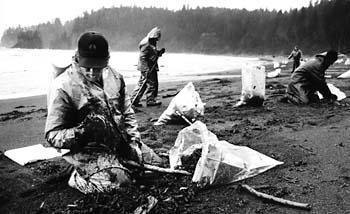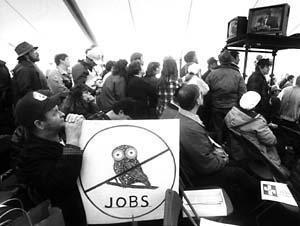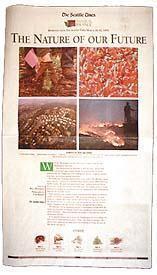Photo Credit: Benjamin Benschneider / Seattle Times. A dead seabird gave pause as workers cleaned up oil-soaked
debris from a 1988 tanker spill off the Olympic Peninsula.
A dead seabird gave pause as workers cleaned up oil-soaked
debris from a 1988 tanker spill off the Olympic Peninsula.
ON A DAY NO ONE WHO LIVED THROUGH IT WOULD EVER FORGET,
the people of the Northwest experienced nature at its most powerful. Early on May 18,
1980, Mount St. Helens erupted, heaving out searing gases, tons of rock and acres of mud,
dumping deep layers of volcanic ash over three states and killing more than 60 people.
For 15 miles around the explosion, forests were flattened,
riverbeds filled by avalanches and most living things obliterated.
Yet in a decade that began with such a devastating reminder of nature's
potential fury, the 1980s focused more on its fragility -- on the environmental disasters
created by man rather than nature. Signs of the degradation of the Northwest's most recognized
attributes -- its towering forests, fish-filled waters and scenic vistas -- had become all too common.
The region had to face serious ecological problems that had national, even worldwide, implications.
As environmental consciousness grew, so did conflicts over the industries
that had initially attracted people to the area and made it prosper. Mining, logging and fishing,
as well as processing and shipping were straining natural resources. Predictions that the population
would continue to soar increased the pressure on these industries.
Environmentalists called for new priorities, or at least a critical re-evaluation
of old ones. Their fears for the Northwest way of life mounted as oil spills polluted the waters and
overcutting threatened ancient trees. Seabirds coated with sticky crude and spotted owls
disappearing from the woods were only the most visible symbols of the increasing threat to entire
ecosystems.
In the '80s, Washington became a testing ground for environmental legislation and a battleground
over the balance of nature and human livelihoods.
 The Northern spotted owl was the little bird that started the big war over the fate of
the region's old-growth forest ecosystems.
The Northern spotted owl was the little bird that started the big war over the fate of
the region's old-growth forest ecosystems.
Photo Credit: Tom Reese / Seattle Times.
PERHAPS MOST EMBLEMATIC OF THESE STRUGGLES WAS THE FUROR OVER THE SPOTTED OWL.
Backed by the 1973 Endangered Species Act and other laws on land use, environmentalists seized on
the owl's decline to force a broader debate over forestry practices and the fate of the owl's habitat,
old-growth timber.
The U.S. Forest Service's first study, completed in 1988, recommended that 360,000 acres of old-growth
forest be set aside for the owls; the previous year, timber harvests in Washington peaked at
4.6 billion board feet (enough to build nearly 320,000 average American homes).
Yet further research indicated that the owl was only one of 667 species
living within the old-growth ecosystem, and estimates of the needed "critical habitat" climbed
from 7.7 million to more than 11.5 million acres. As the federal court stepped in to block timber
sales and force compliance with environmental laws, harvests dropped more than 30 percent.
Sporting "Save a Logger" shirts, timber workers rallied in the state
capital to plead for jobs.
Presidential intervention and a 1993 forest conference brought national attention to the Northwest,
but only limited movement toward long-term solutions.
 Small mill owners and independent loggers, hardest hit by cutbacks in timber sales,
rallied against the loss of their way of life.
Small mill owners and independent loggers, hardest hit by cutbacks in timber sales,
rallied against the loss of their way of life.
Photo Credit: Mark Harrison / Seattle Times.
SIMILAR ATTENTION WAS FOCUSED ON THE REGION'S HANDLING OF ANOTHER SERIOUS
ENVIRONMENTAL PROBLEM, OIL SPILLS. As world demand for petroleum products grew,
so did the potential to harm the waters through which oil tankers traveled.
Then-Sen. Warren Magnuson helped get federal support for banning the largest carriers,
supertankers,
in Puget Sound. Nonetheless, Washington experienced its most serious oil spill in December
1985, when the Arco Anchorage ran aground off Port Angeles, leaking nearly 240,000 gallons of
crude oil. Volunteers rushed to clean up miles of blackened beaches and rescue several thousand
oil-soaked birds, although many more perished.
The state responded with new liability laws and recommendations
for increased tanker safety. But it took an even bigger disaster, the 1989 wreck of
the Exxon Valdez in Alaska, to shock the nation into recognizing the problem. Calls
for more protective features on tankers as well as more stringent federal regulation
and enforcement addressed environmental issues, but required huge economic commitments.
Washington had already led the way in debating the environmental effects
of another energy alternative, nuclear power. Hanford in southeast Washington, home of World War
II plutonium production for "the bomb," became the site for three new nuclear-power plants in the
1970s. But safety concerns prompted by the 1979 accident at Pennsylvania's Three Mile Island helped
sink the project, causing the largest municipal bond default in U.S. history.
State voters also nixed plans to store more radioactive waste at the already
polluted site. The price of this protection was more jobs.

Times special sections throughout the 1980s dealt with ecological concerns. Example at left.
IN 1989, THE SEATTLE TIMES COMMISSIONED NEAL PEIRCE, a national commentator on local-government issues, to assess the region's direction on the question of balancing environmental and economic priorities. Peirce and his team began their report with a question: "Is Puget Sound Paradise Lost?" The answer, in short: "Not yet, but soon."
The report warned of a "nightmare" born of unchecked growth, but it offered some
hope that with planning, focused expansion and governmental cooperation, the bad dream could be averted.
Whether or not Peirce's suggestions could help Seattle maintain its highly
touted livability, the problems he identified obviously reached beyond city limits.
Their resolution also required a broader commitment. As the manmade environmental disasters
of the '80s showed, without a balance between natural and human concerns, saving Paradise would
be difficult, indeed.
Historians Sharon Boswell and Lorraine McConaghy teach at local universities and do research,
writing and oral history. Original newspaper graphics courtesy of the Seattle Public Library.